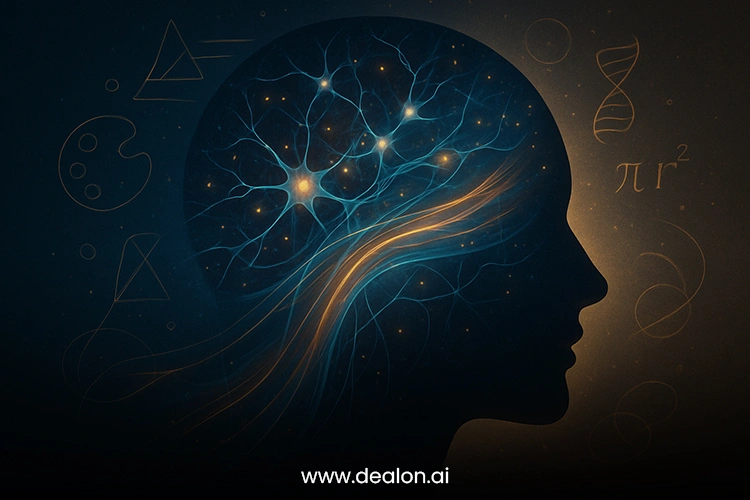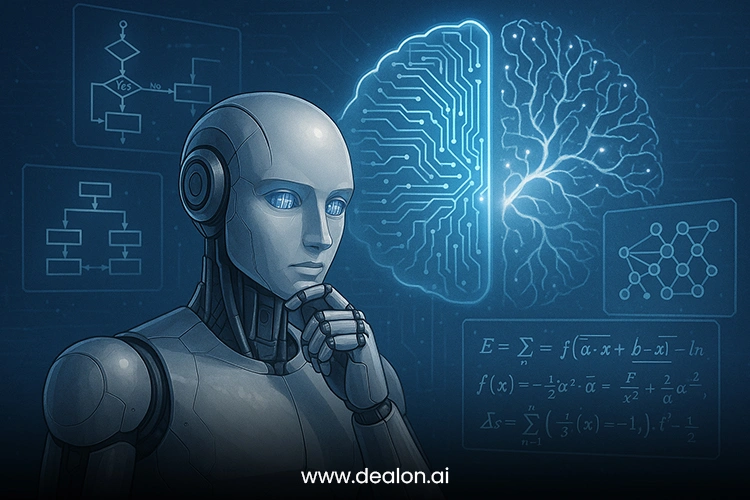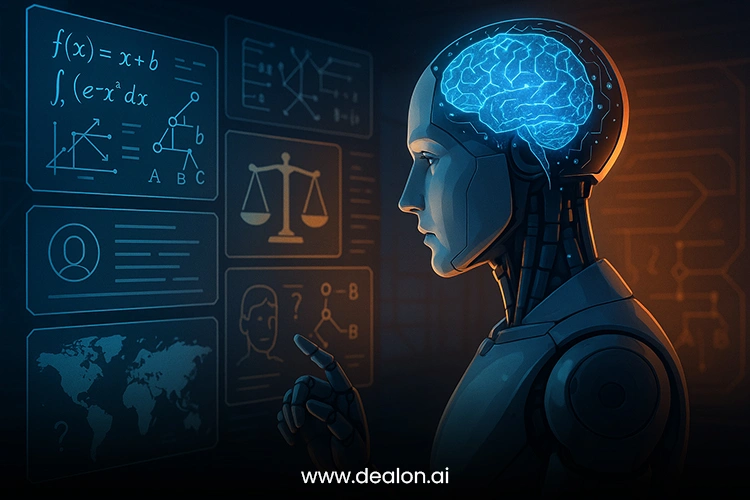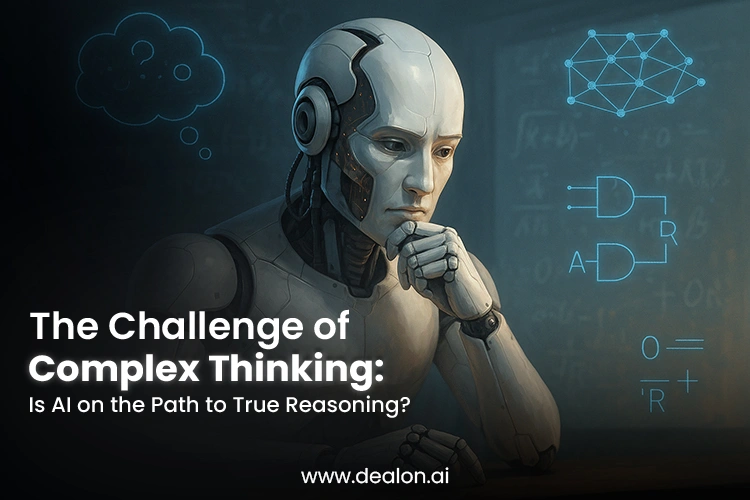The brisk Advancement of Artificial Intelligence has triggered profound disagreements regarding its capability to think and process information like a human. As AI continues to revolutionize industries from medicine to banking, its proclivity to simulate human reasoning beckons a rather fascinating line of inquiry: Can AI, in any of its forms, engage in human-like problem solving? Modern Artificial Intelligence Systems can identify patterns, process, and analyze vast amounts of data, and even produce highly coherent human language. Still, such systems are highly siloed and lack the agility of human thought.
The unique marker of human cognition, valid thinking, goes beyond executing programmed instructions or manipulating expansive databases. It also includes the use of ethical principles, the handling of ambiguity, innovation, and abstract reasoning. In relation to the human side, decision-making is a tangled combination of sensations, thoughts, and experiences.
At the same time, AI, advanced as it may be, relies on data input and calculated responses. That raises the concern: is AI the sum of its parts – a complex arrangement of shifting components that equates to thoughtless mechanized behavior, or does the ‘mind’ of AI defy such definitions and partake in real thinking that involves depth and deliberation?
The more AI is developed, the more paradoxical the advancement of machines compared to AI’s thinking ‘skills’ seems to become. While celebrating advances made in neuromorphic computing and reinforcement learning, the ability to think critically continues to challenge thinkers. This paper seeks to elucidate the challenges of deep thought in AI by taking stock of the frontiers of cognition in machines, the hurdles to be crossed, and the pathways yet to be defined to endow machines with human-like cognitive capabilities.
The evolution of AI has made the technology and its discussions strategically center around its ability to mimic and complete Herculean human tasks, and systems have been designed to do just that. AI systems have made and continue to make leaps in terms of functionality; however, the sophistication of thought the machine exhibits continues to be a challenge. And therein lie the cracks in AI’s cognitive capabilities.
Currently, AI systems perform optimally in fields where computational resources and machine learning algorithms can be used in abundance. Through deep learning, which is a category of machine learning, AI systems have been trained and have become proficient in Natural Language Processing, identifying, and even generating human-like text across images. AI models such as GPT-3 produce sentences that are coherent and contextually relevant, all the while in a style that closely resembles human text. There is also the use of AI systems in facial recognition, medical diagnostics, and automatic trading in stocks, where the system’s processing capabilities of complex data exceed those of a human.
Do not confuse these accomplishments with actual cognitive thought. At the core, the functions of AI are grounded in probabilities and a fixed set of instructions. AI can imitate thinking on a minimal and well-defined level, but the ability to honestly evaluate—especially in cases that are not predetermined—is still highly underdeveloped. Complex AI technologies still depend on training data and are unable to function outside of these rigid boundaries.
In other words, an AI’s thought process is associative in nature and, more often than not, will lack critical evaluation. This is essential to outlining the gaps in cognition that are present in most AI technologies today. Unlike the thinking that AI employs, actual cognitive processing involves more than just output conditioning an input. It is more complex, necessitating an understanding and an ability to multitask, like considering the context, values, and even ambiguity that these problems might present. This is what complex thinking is all about.
Also Read: Exploring the Capabilities of Gemini, Gato, and the Next Generation of Multimodal AI
The Core of Complex Thinking

The thinking process becomes more sophisticated with time. It includes the ability to assess contradictory or subtly different situations. Humans can approach a problem with more than just logical reasoning and can demonstrate imagination, compassion, and integrity. Humans can assimilate disparate domains of knowledge, say, intuitions and life experiences, and converge them in ways unreproachable by contemporary sophisticated devices.
In comparison, AI stumbles in situations beyond its training data. It can effectively pinpoint patterns in data it has previously encountered, but it is unable to do so if the patterns cease to exist or contradict each other. An example of this is an AI programmed to scan and analyze legal documents. It can flag ‘inconsistencies’ within ‘typical’ contracts; however, it will be unable to do so if the contracts deviate from the norm or encompass situations that the AI has never encountered. The performance gap is because AI lacks the cognitive and heuristic capacities humans invoke in tackling the unfamiliar.
To AI and human beings, an AI’s and a human’s abstract reasoning capability and synthesis of unlike concepts is one of the differences. People can develop fluid, flexible mental images of a given situation and can think of a plausible scenario when given insufficient and even conflicting information. For example, when reading a book or watching a movie, people are able to discern subtle meanings, assess the motivations of characters, and anticipate future behavior based on their appreciation of human nature. In stark contrast, AI does not possess deep abstraction and is challenged by ambiguity and wildcards.
Additionally, above and beyond problem-solving, complex thinking includes originality. People are able to produce novel ideas by integrating their knowledge across a number of fields alongside emotional and social stimuli to form entirely new ideas. AI, although it simulates ‘creativity’ by producing newer combinations, is restricted to its data set. It is incapable of generating new possibilities or being creative in the ways that humans are. Therefore, complex thinking stems from the integration of reasoning, emotion, and intuition—a triad that AI systems currently find difficult to attain.
On the contrary, AI’s inflexible reasoning processes tend to fail in the presence of contradictions or the unknown. If the constraints that govern its behavior are broken, the system completely lacks the flexibility that human thought processes tend to offer. AI can learn with experience, but only to a certain level, because there are stringent boundaries within which the system operates, and there is a total absence of the self-driven, innovative thinking that human intelligence is so well-known for.
Artificial Intelligence and Reasoning

Absence of Generalization
The absence of a generalization ability is one of the most critical issues stalling the advancement of actual reasoning within AI frameworks. While systems of AI perform exceptionally well at completing a task within boundaries, their functionality is often relegated to a siloed vertical. This is starkly different from the case with sentient beings, who perform a spillover of knowledge or skill over multiple boundaries with ease.
For example, an individual who has learned how to solve a problem in mathematics can, more often than not, venture to apply the same principles across an entirely different discipline, such as economics or engineering. AI systems, on the contrary, need to go through a retraining or fine-tuning exercise to cater to new problems that lie outside the problem statement given. This lack of generalization capacity makes AI systems and tools far less flexible to the complexities of the real world.
Contextual Awareness
The human mind often integrates several social, emotional, and situational elements when making decisions. These elements, together with situational feedback, usually shape the information that formulates a decision. For these reasons, the meaning of a statement is also understood as more than the mere articulation of the constituent phrases.
It involves considering the tone, the speaker, and the social context. Defeating as it may seem, AI systems struggle with meaning interpretation. Situational context analysis is done in silos. Lacking situational context and a degree of context sensitivity, intuition hinders the ability to function in non-static conditions. AI systems have a distinct lack of reasoning abilities, particularly about human beings and their intricate social contexts, because they fail to situationally reason.
Reasoning Ethically and Morally.
When it comes to ethical and moral reasoning, it has come to the attention of many that it has brought about several difficulties in addressing the moral questions that AI has set out to achieve. To explain, a human’s line of thinking has always been swayed by certain morals, cultures, and ethics that control their actions, more so when faced with ethical dilemmas.
For an AI, the situation is far more complicated, as certain restrictions and boundaries have been put in place, and there is no form of moral ethics that AI deals with, simply logic. AI can provide a technically accurate answer; however, the answer it gives can be morally wrong. Take, for instance, an AI that has been programmed to solve a problem under the premise of achieving maximum efficiency. The logical solutions that come up are far outweighed by and in conflict with the ethical standards present in a society.
Creativity and Innovation
Reasoning can also be characterized as creativity—the ability to go beyond imagined boundaries and possibilities. AI can produce creative ‘novels’ as long as its data is based on something real. AI can only go as far as data training allows. Thinking outside the box and generating something completely new is nonexistent as far as AI is concerned. However, human reasoning can construct concepts out of thin air that defy and democratize the innovator’s dilemma and break free from orthodox thought. In overcoming intricate challenges, the ‘impossible’ is thought up and imagined. This is the creative spark, and this is the very thing that AI is unable to replicate.
Does AI Have the Potential for True Reasoning?

Even though there are still obstacles on the road to actual reasoning, the promise of AI research is bright. In particular, the movement toward neuromorphic computing intends to duplicate the workings of the human brain and thereby significantly improve AI. ‘Neuromorphic’ pertains to the emulation of the brain’s network structures and systems, and AI is able to adapt to context with greater ease. Therefore, this technique promises to improve the fluidity with which machines process information and think deeply, analogous to human neural activity.
Reinforcement learning is a technique wherein machines learn their environment through direct interaction and feedback, and in this case, it is used to describe a scenario where AI deduces multi-step actions from singular, real-time human commands, which represents another leap in machine reasoning. Machine learning, which is implemented in reinforcement learning, allows more freedom and complexity versus being static on a predetermined function.
It is already acknowledged that reinforcement learning is at a more advanced stage than other machine learning branches, such as game playing or robotic control. These implementations, from games to robotic control, reinforce learning through trial and error, also called practice. Enhancing these systems could sharpen their understanding, which is beyond decision-making to develop human-like reasoning.
Reducing machine reasoning to simply improving data-oriented functions is not a conclusion one can draw. Human reasoning is versatile, emotionally intelligent, and ethically aware, and as such, considerations of such AI systems are lacking. The human-machine interface must work in such a manner that the machine not only reasons, processes data, or equates, but also understands the hierarchy of reasoning to contextualize, decision-making, and the consequences on ethical grounds.
Machine reasoning would have to extend beyond computations or functions to reinsert human values along with moral responsibility. It is this complexity that poses the question of whether AI truly possesses reasoning or if such reasoning is merely an unmapped, idealistic concept.
The Future of AI and Advanced Thought
The future of artificial intelligence is unpredictable and expansive, and whether AI can ever accomplish an equivalent form of reasoning remains to be seen. AI stands to gain quite an advantage in sophistication, which would allow AI to rationalize in a manner analogous to humans, and this person does not seek to underestimate the philosophical and ethical implications of doing so.
These issues move to the forefront of the question dealing with rational AI – what will be the control, as well as the responsibility? If reasoning is indeed an independent process, what mechanism will allow that reasoning to function? Will it be the Rational AI or a human? If an AI acts, would the person that the AI is acting for be held liable for whatever consequences arise? The mere existence of such questions is an indication of the paradigm shifts advanced reasoning for machines can lead to, and compel us to question what we have thus far assumed to be the foundations of law and morality.
There is an ethical dimension to considering artificial intelligence reasoning and even thinking in human terms — and this makes such exercises highly speculative. What might the implications be for human civilization if machines can reason, make decisions on their own, and even pursue autonomous goals?
Would their existence impart some level of consciousness, or are they merely the products of highly sophisticated systems engineering? Such questions are not purely of a technological nature, but rather touch upon the moral and philosophical dimensions of humanity, which will most likely be encountered by almost anyone working in the AI field, be it scientists, ethicists, or even technologists.
Conclusion
Although AI has made tremendous progress in recognizing and processing patterns, there is plenty of work needed to achieve actual reasoning. Inferencing, ethics, and the ability to create are critical barriers AI faces to mimicking human-like thinking. Even with the progress made in reinforcement learning and neuromorphic computing, AI has a long way to go in achieving actual reasoning.
Indeed, the possible prospects of the segment are relatively bright, though it does bring along new ethical and philosophical issues concerning self-governance, accountability, and the nature of artificial intelligence. Activities oriented towards the very pursuit of machines that can ‘think’ and ‘reason’ like human beings will, likely, continue to provide scopes of endeavours for many generations to come.

